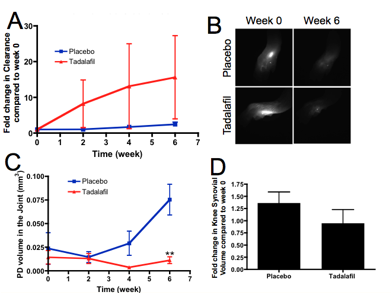Session Information
Session Type: Abstract Submissions (ACR)
Background/Purpose: Rheumatoid arthritis (RA) is a chronic inflammatory joint disease with enigmatic episodic flares. Using longitudinal imaging, we recently demonstrated that arthritic knee flare in tumor necrosis factor transgenic (TNF-Tg) mice is associated with the loss of the lymphatic pulse and B-cell clogging of the lymphatic sinuses in the adjacent popliteal lymph node (PLN), which is ameliorated by B-cell depletion therapy that restores passive lymphatic flow from inflamed joints. To test the hypothesis that similar efficacy can be obtained via vasodilatory therapy that opens lymphatic vessels parallel to the clogged PLN, we evaluated the effects of tadalafil, a FDA-approved PDE5 inhibitor, on lymphatic transport, synovitis and bone erosion in TNF-Tg mice experiencing knee flare.
Methods: TNF-Tg mice with collapsed PLN underwent contrast enhancement MRI (CE-MRI), power Doppler (PD) ultrasound, near infrared indocyanine green (NIR-ICG) imaging prior to and after treatment via gavage every other day with tadalafil or placebo for six weeks.
Results: Fold change in ICG clearance from the footpad, a marker of lymphatic transport, was found to be higher in tadalafil treated animals compared to placebo (15.62±23.25 vs. 2.77±1.17) (Figure 1A and B). As expected, lymphatic contraction frequency decreased over time in the placebo and tadalafil treatment groups, consistent with progression of the disease and lymphatic dilation respectively. Lymph node contrast enhancement (LNCE), an alternative biomarker of lymphatic transport to the PLN that is measured via CE-MRI, decreased slightly (0.87±0.10 fold change) in the placebo group, indicating further PLN collapse. In contrast, tadalafil induced a slight increase (1.05±0.12 fold change) in LNCE, indicating a halt in PLN collapse. Additionally, mice treated with tadalafil showed a greater PLN volume compared to placebo (15.56±10.15 mm3 vs. 9.97±6.09 mm3), indicative of increased transport to the PLN. PD within the joint, a measure of inflammation, was found to be significantly lower after tadalafil treatment compared to placebo (0.011±0.01 mm3 vs. 0.08±0.02 mm3) (Figure 1C). Placebo treated animals were shown to have a 1.36±0.23 fold change in knee synovial volume, while tadalafil treatment showed a lower fold change, 0.95±0.28 (Figure 1D).
Conclusion: Tadalafil treatment increases passive lymphatic transport, as evidenced by increased ICG clearance, PLN volume and LNCE; in conjunction with decreased lymphatic contraction. In addition, this increase in lymphatic transport results in decreased PD volume within the joint, indicative of decreased joint inflammation. These results in addition to flow cytometry and histology of joints and PLNs will be presented.
Disclosure:
E. M. Bouta,
None;
I. Kuzin,
None;
R. Wood,
None;
C. T. Ritchlin,
Eli Lilly and Company,
9,
Eli Lilly and Company,
5;
A. Bottaro,
None;
E. M. Schwarz,
Johnson & Johnson,
5,
NIAMS-NIH,
2.
« Back to 2014 ACR/ARHP Annual Meeting
ACR Meeting Abstracts - https://acrabstracts.org/abstract/tadalafil-decreases-joint-inflammation-in-tnf-tg-mice-by-restoring-passive-lymphatic-transport/

